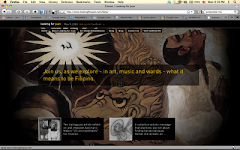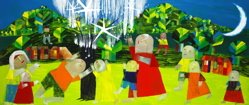========================================
Looking for the Filipino, not just Pacquiao
 MANILA, Philippines – Projects that deal with the creation of a Filipino identity are always bound to be met by debate and objections, violent reactions and a lot of hair-pulling. And rightfully so.
MANILA, Philippines – Projects that deal with the creation of a Filipino identity are always bound to be met by debate and objections, violent reactions and a lot of hair-pulling. And rightfully so.
At a time when we are being told that Manny Pacquiao is our sense of identity, we must be able to kick and scream our way toward a better sense of who we are.
“Looking for Juan Outdoor Banner Project,” an art exhibit organized by the Center for Art, New Ventures and Sustainable Development (Canvas), seems to be a step in the right direction. With artists asked to create works that respond to the question of Filipino identity, the first batch of paintings on exhibit at the Cultural Center of the Philippines (CCP) is telling of the individual minds of our young contemporary artists. It is indicative of where we are as a nation.
On that hot evening of the exhibit’s opening night, the slew of paintings hanging on the walls of the second- and third-floor hallways and the Little Theater lobby wall of the CCP was surprisingly refreshing.
The youthfulness was hard to ignore, owing to the bright optimistic colors on the canvases. Even when a given canvas dealt with dark hues, there seemed to be something light and pleasant about the general look of the paintings.
Heartwarming
It could have been the familiarity of it all as well. From afar, the amalgamation of images of being Pinoy [Filipino] (the jeepney, the Filipino child, a person sweeping, people smiling into camera phones) couldn’t help but be heartwarming. But it was almost a warning: The concern for identity, after all, is an overdone concern of the arts, and as such it does quite often become cliché.
As some of the works on exhibit are falling into the trap of using overdone stereotypes of the Filipino: the Pinoy as unique in the ability to smile in the midst of pain (“Galos Lang,” by Jeff Carnay) and oppression due to unjust laws (“Juan Line,” by Dansoy Coquilla); to walk to the beat of our own drum (“Hataw sa Traffic Light,” by Marcial Pontillas); and to rise above adversity, given our heroic history (“Like Our Heroes, We Will Rise,” by Anthony Palo).
The realism that the first three work with doesn’t leave much for interpretation—a function as well of its being cliché—while the latter is, strangely enough, a representation of people flying with and on a hot-air balloon, an image that connotes social class mobility. Is this to say who can become hero?
Many others, while dealing with realistic images of poverty, corruption and oppression, end up talking about universal notions of environmentalism (“Juanderful World?” by Anna de Leon); unity (“Maybe We Are the Pieces,” by Jay Pacena II); personal struggle (“Sari-sari Storm” by Maan de Loyola); determination (“The Rise of Juan Tamad,” by Lotsu Manes); and hope (“The Traveller,” by Palma Tayona). Understandably, it is these pieces as well that have more to say on the canvas. Oppressive information
Oppressive information
Pacena’s piece in particular screams against the oppression of information, with a blindfolded image up-close, mouth filled with three-dimensional puzzle pieces. With eyes unseen and face half-covered, this is a statement on every Juan and Juana: You are being defined by too much, even as you remain unknown.
The clichés notwithstanding, a lot of thinking obviously went into many of the artworks. This is particularly true for the more politically charged ones, those that speak of the true conditions of the nation, and deal with it head-on.
There is the truth of poverty and how it understandably sacrifices hope (“Juan Luma,” by Migs Villanueva); the contemporary Filipinization of what is foreign and how this hybrid identity is problematic in its abstraction (“Hybrid Nation,” by Jucar Raquepo); the static state of the nation as potential never fulfilled (“Penoy,” by Manny Garibay).
But it is the flair for the revolutionary that is striking about this exhibit. “Biyahe ni Juan,” by Omi Reyes, “Aklas… Baklas… Lakas… Bukas!” by Marika Constantino, “Panata,” by Salvador Ching and “Pinoy Big Brother,” by Buen Abrigo are priceless not just in their imageries but also in their call to action.
Reyes’ close-up image of a jeep seems cliché, but its movement challenges the audience to an engagement: Where are you going, and why? This is true as well for Ching’s use of a Filipino everyman doing the Catholic devotees’ sacrifice of self-flagellation. This man, though, is facing a bright red moon, his bare back bloodied—the Juan is himself the sacrifice, as he is the one facing the possibility of revolt with the red, red moon.
And while the image of two arms clasping each other in Constantino’s work could seem cliché as well, its flowing red background connotes the rage and revolt that seem all possible. Need for change
Need for change
But it may be Abrigo who creates the image of contemporary times as transnational neocolonial: An unstable building and tower is filled with everything commercial that permeates our everyday lives. Figures beneath these structures are of a masked GMA/Imelda, a two-faced man in shadows, and a zombie-like creature with laser eyes.
All of these are contextualized in the dark neglected buildings in the background—a telling sign of how the capitalist enterprise silences the nation. The eeriness reeks of injustice and murder, and this is precisely what works for “Pinoy Big Brother.” It highlights the need for change, the need to end the oppression that capital brings.
If only for Abrigo’s as well as Reyes’ and Ching’s works, and in the context of the highly debatable concepts of nation and identity, “Looking For Juan” is a must-see. It is on view at the CCP until June 7, after which it moves to Alab Art Space of the Intellectual Property Office, IPO Bldg., Gil Puyat Avenue, Makati City, on June 8. Visit www.canvas.ph.
From top to bottom: "Panata" by Salvador Ching; "Biyahe ni Juan" by Omi Reyes; and "Pinoy Big Brother" by Buen Abrigo.





No comments:
Post a Comment